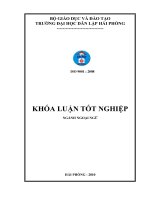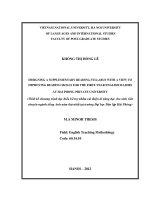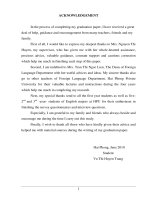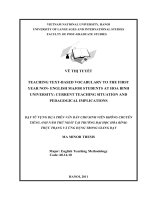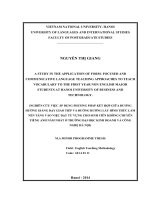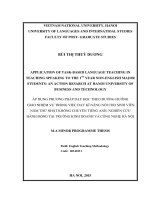How to teach countable and uncountable nouns to the 1st year non- English majors of Hai Phong Private University
Bạn đang xem bản rút gọn của tài liệu. Xem và tải ngay bản đầy đủ của tài liệu tại đây (1.15 MB, 83 trang )
1
Hai phong private university
Foreign languages department
*****
Graduation paper
How to teach countable and uncountable
nouns to the first year non- English majors
of Hai Phong Private University
By:
Lª ThÞ Ngêi
Class:
na903
Supervisor:
NguyÔn ThÞ HuyÒn, ma
Hai phong, 2009
ISO 9001 - 2008
2
Bộ giáo dục và đào tạo
Tr-ờng đại hoc dân lập hải phòng
Nhiệm vụ đề tài tốt nghiệp
Sinh viên: Mã số:
Lớp: Ngành:
Tên đề tài:
3
Nhiệm vụ đề tài
1, Nội dung và các yêu cầu cần giải quyết tronh nhiệm vụ đề tài tốt nghiệp (
Về lý luận, thực tiễn, các số liệu cần tính toán và các bản vẽ)
2, Các số liệu cần thiết để thiết kế, tính toán.
3, Địa điểm thực tập
4
Cán bộ h-ớng dẫn đề tài tốt nghiệp
Ng-ời h-ớng dẫn thứ nhất:
Họ và tên:
Học hàm, học vị:
Cơ quan công tác:
Nội dung h-ớng dẫn:
Ng-ời h-ớng dẫn thứ hai:
Họ và tên:
Học hàm, học vị:
Cơ quan công tác:
Nội dung h-ớng dẫn:
Đề tài tốt nghiệp đ-ợc giao ngày tháng năm
Yêu cầu hoàn thành tr-ớc ngày tháng năm
Đã nhận nhiệm vụ Đ.T.T.N Đã giao nhiệm vụ Đ.T.T.N
Sinh viên Cán bộ h-ớng dẫn Đ.T.T.N
Hải Phòng, ngày tháng năm
Hiệu tr-ởng
5
Phiếu nhận xét tóm tắt của cán bộ h-ớng dẫn
1. Tinh thần thái độ của sinh viên trong quá trình làm đề tài tốt nghiệp
2. Đánh giá chất l-ợng Đ.T.T.N ( so với nội dung yêu cầu đã đề ra trong
nhiệm vụ Đ.T.T.N trên các mặt lý luận , thực tiễn, tính toán giá trị sử dụng,
chất l-ợng các bản vẽ)
3. Cho điểm của cán bộ h-ớng dẫn:
( Điểm ghi bằng số và chữ)
Hải Phòng, ngày tháng năm
Cán bộ h-ớng dẫn chính
(Họ tên và chữ ký)
6
Nhận xét và đánh giá của cán bộ chấm phản
biện đề tài tốt nghiệp
1. Đánh giá chất l-ợng đề tài tốt nghiệp về các mặt thu nhập và phân
tích số ban đầu, cơ sở lý luận chọn ph-ơng án tối -u, cách tính toán chất
l-ợng thuyết minh và bản vẽ, giá trị lý luận và thực tiễn đề tài.
2. Cho điểm của cán bộ phản biện
( Điểm ghi bằng số và chữ)
Ngày tháng năm
Ng-ời chấm phản biện
7
Table of contents
Acknowledgement.
Part one : introduction
1) Rationale 1
2) Aims of the study 2
3) Scope of the study 3
4) Methods of the study 3
5) Designs of the study 3
Part two : development.
Chapter one : Theoretical background
I. English nouns.
1) What is noun ? 5
1.1 Definition 5
1.2 Types of nouns 6
1.3 Proper nouns 7
1.4 Common nouns 7
2) How to identify countable and uncountable nouns 8
2.1 What is countable noun? 9
2.1.1 Categories of countable nouns 10
a) Collective nouns 10
b) Proper nouns 10
c) Concrete nouns 10
d) Abstract nouns 10
2.1.2 Using articles with countable nouns 10
2.1.3 Using the singular form of the verb with a singular countable noun 11
2.2 What is uncountable noun? 11
2.2.1 Categories of uncountable nouns 11
a) Concrete nouns 11
b) Abstract nouns 12
8
c) Collective nouns 12
d) Non-plurals with ―s‖ 12
2.2.2 Using articles with uncountable nouns 12
3) Noun which can be either countable or uncountable nouns 14
3.1 Differences in meaning 14
3.2 Referring to objects or material 15
3.3 Referring to something specific 15
3.4 Nouns endings ―- ing‖ 15
3.5 Selected uncountable nouns and their countable equivalents 16
3.6 Normally uncountable nouns used as countable nouns 16
3.6.1 General partitives 17
3.6.2 Specific partitives 17
II) Techniques in teaching countable and uncountable nouns 18
1) Lecture and discussion methods 18
2) Pair and group work 19
3) Games and simulations 19
4) Pictures 20
5) Instructional media 20
Chapter II : The study on learning and teaching
English at Hai Phong private university
I. Reality 22
1) Context 22
2) Teachers 22
3) Students 22
4) Teaching and learning condition 23
5) The design and focus of the English the book “Reward” 24
II Survey questionnaires 25
1) Method of survey 25
9
2) Objectives of survey 25
3) Data analysis 26
3.1 The surveyed students ‘general attitudes toward English 26
3.2. Current situation of studying techniques an English countable and
uncountable nouns lesson 29
3.3. Students‘ expectations about a new teaching method 33
4) Findings and discussion of findings. 37
Chapter three : Some suggested techniques in
teaching countable and uncountable nouns for the
first year non- English majors
I. Reasoning 39
II. Suggest activities for teaching 39
1 Teaching through visual aids 39
2 Teaching by pictures 41
2.1 Example application for teaching by picture 41
2.1.1 Explaining the difference about meaning 42
2.1.2 Explaining the partitives 43
2.1.3 Picture discussion 45
3 Teaching through games 46
3.1 Activity1 47
3.2 Activity 2 48
3.3 Activity 3 48
4 Finding words 49
4.1 Word search 49
4.2 Crossword 50
4.3 Guess the word 51
4.4 Chain recipe 52
4.5 Get rid of it 53
4.6 Creating a poem 54
4.7 Cross out the words 54
10
4.8 Short talk 56
4.9 Original metaphors 57
5 Nouns quiz 58
6 Extract nouns 58
6.1 Extract nouns from sentences 58
6.2 Extract nouns from paragraphs 59
Part III : conclusion 61
References
Appendix
11
HAI PHONG, JUNE 2009
Acknowledgements
In the process of implementing my research paper, I have received a lot
of help , encouragement and experiences from teachers and friends .
Especially , my graduation subject now is completed successfully thanks to
all teachers‘ support in Hai Phong Private University (HPU ).
First of all , I would like to express my sincere thank to my supervisor
Mrs. Nguyen Thi Huyen, M.A who has generously given me invaluable
assistance and guidance. Without her help, this paper will not successfully
done.
Besides, my sincere thank is also extended to all the teachers in
Department of Foreign language for their lectures supporting this study,
Simultaneously, my thank to all the students who help me fulfill the survey
question. Last but not least , I am grateful to my family and friends who
have given me much encouragement during the time I carried out this paper
Students
Ngoi
Le Thi Ngoi
12
Part one : introduction
6) Rationale
English is a global language used by millions of people all over the world.
Obviously, English connects people, shortens the distance and makes every
body closer and closer.
In modern society , it is considered as an indispensable language in the
process of communicating with various kinds of people from different
courtesies. Mastering English is the best way for us to have a great deal of
opportunities to reach the success in life.
As a matter of fact , it is not easy to study well a foreign language like
English. Almost students have difficulties in studying vocabulary at first. In
fact, studying vocabulary well is one of the key which helps learners step by
step discover this interesting language. To the beginners, vocabulary is the
most important role in integrating four basic skills such as listening, speaking,
reading and writing. In order to use English as an effective tool in
communication, students have to equip an quite enough knowledge about
vocabulary, including meaning, form, word form and grammar. A lack of
vocabulary development affects students' reading comprehension and their
writing skills, influencing future success and career choices. Vocabulary
learning particularly affects the success of English learners;
Studying English nouns as the foreign language comes lot of difficulties for
the learners. The store of various vocabulary is really complicated, some of
them are easy but some are so difficult to understand and memorize.
Especially, students have difficulty in studying English countable and
uncountable nouns. For one thing, the determination of what nouns are
countable and what nouns are non-countable is by no means universal. For
instance, although somebody can advise us several times, we can't say they
give us advises, although that would translate quite nicely into several other
13
languages. We would say, in English, that they give us advice. In some
languages, it makes sense to sit in a restaurant with a friend and ask for waters
(and get two glasses of water) — something that would sound quite peculiar
in English. There fore, teaching countable and uncountable nouns for learner
requires a special teaching action and teaching methods completely different
from those for. Here the object I want to focus is the 1
st
non- English majors
In my opinion the most important aspect of countable and uncountable nouns
teaching for advanced learners is to foster learner independence so that
learners will be able to deal with new lexis and expand their vocabulary
beyond the end of the course. Therefore guided discovery, contextual
guesswork and using dictionaries should be the main ways to deal with
discovering meaning.
Due to my English knowledge limitation and the frame of the graduation
paper, I make a sketchy presentation on some effective methods of studying
countable and uncountable nouns with hope that this can help the 1
st
year non-
English majors in Hai Phong Private University. In the future time, they will
study English for special purpose which requires lots of vocabulary. From the
above reasons, I would like to choose the research paper entitled : ― how to
teach countable and uncountable nouns to the 1
st
year non- English majors of
Hai Phong Private University‖ to help the mentioned students as well as
others enrich their English countable and uncountable nouns.
7) Aims of the study
The main goal of my research paper is to provide some suggested techniques
in teaching countable and uncountable nouns for the first year non- English
majors to make students more interested in the lesson as well as to master
learnt knowledge of that lesson in an effective way. In order to gain that aim,
the specific objects of the study are:
14
To study the theory of countable and uncountable nouns, its usage and
some techniques for teachers to apply.
To get known about the reality of teaching and learning English at Hai
Phong Private University with specific facts and figures.
To provide some suggested techniques in teaching countable and
uncountable nouns for the first year non-English majors. Basing on those
findings, the study also includes suggested applications for teaching.
8) Scope of the study
In fact, there are lots of various techniques to study English countable and
uncountable nouns. It requires much of time and effort. However, due to the
limitation of time, resources and knowledge of mine, this study can only focus
on study some effective techniques in studying English countable and
uncountable nouns for the 1
st
year non- English majors in Hai Phong Private
University.
9) Methods of the study
To complete this graduation paper, a series of methods have been applied:
Collected references, books and websites related to teaching English
and documents were analyzed in details to form the theoretical back ground
this paper.
A survey questionnaire is conducted for the first year students and
teachers of English at Hai Phong Private University, the information from
which has invaluable.
Suggestions experience from my supervisor Mrs.Nguyen Thi Huyen,
MA, other teachers and my understanding at Hai Phong Private University
and gained experience in training course.
10) Designs of the study
The study is divided into three mains:
Part one is INTRODUCTION that indicates the rationale for choose this
topic, pointing out the aim, the scope as well as the methods of the study.
Part two named THE STUDY, which consists of three chapters:
15
- Chapter1: ― Theoretical background‖ focuses on the way teaching
English grammar and techniques to teach.
- Chapter 2; ―The study on learning and teaching English at Hai
Phong Private University‖ refers to the survey questionnaire and analyzed
findings of questionnaire‘s results.
- Chapter3: ―Some suggested techniques in teaching countable and
uncountable nouns for the first year non-English majors‖ that contains
some techniques to teach countable and uncountable nouns through pictures
and some more suggested activities.
Part three is CONCLUSION in which all the issued mentioned above are
summarized.
Briefly, part 1 has referred to rationale , aims, scopes, method and designs of
the research paper. In the part 2, the study will focus on the literature review ,
the study on learning English of the 1
st
years non- English majors in Hai
Phong Private University and some suggested techniques to teach countable
and uncountable nouns.
16
Part two : development.
Chapter one : Theoretical background
I. English noun.
1) What is a noun?
1.1 Definition.
There are many definitions about noun:
By Christine Lehman, eHow Editor, a noun is a part of speech that can be
either a person, a place or a thing. Nouns are perhaps the easiest part of
speech to pick out. Thus, they are one of the first parts of speech taught to
elementary school children. Schoolhouse Rock, known for its catchy yet
educational songs, has one devoted to identifying nouns.
Another definition of noun is provided by A University Grammar of English
by Randolph Quirk and Sidney Greenbaum, Longman Group: ( Essex,
England. 1993) : ― a noun tells us what someone or something is called. For
example, a noun can be the name of a person (John); a job title (doctor) ; the
name of a thing (radio) ; the name of place (London) ; the name of
quality(courage); or the name of an action (laughter; laughing). Nouns are the
names we give to people, things, places, etc in order to identify them. Many
nouns are used after determiner, e.g. the , a, this, and often combine with
other words to form a noun phrase ; E.g. the man next door, that tall
building,
According to Lexico - Grammatical Difficulties of English by Deeva I.N.
Leningrad.1976, A noun is the name of a person, place, thing, or idea.
Whatever exists, we assume, can be named, and that name is a noun. A proper
noun, which names a specific person, place, or thing (Carlos, Queen
Marguerite, Middle East, Jerusalem, Malaysia, Presbyterianism, God,
Spanish, Buddhism, the Republican Party), is almost always capitalized.
Common nouns name everything else, things that usually are not capitalized.
A group of related words can act as a single noun-like entity within a
17
sentence. A Noun Clause contains a subject and verb and can do anything
that a noun can do:
What he does for this town is a blessing.
A Noun Phrase, frequently a noun accompanied by modifiers, is a group of
related words acting as a noun : the oil depletion allowance ; the
abnormal, hideously enlarged nose.
There is a separate section on word combinations that become Compound
Nouns — such as daughter-in-law, half-moon, and stick-in-the-mud.
1.2 Types of nouns.
All nouns fall into one of two classes. They maybe either proper nouns or
common nouns.
_ Some nouns referring to one particular person or place are called proper
nouns, and they always have a capital letter. (The word "proper" comes from
French proper meaning "one's own".) Most proper nouns do not have the in
front of them. _ Nouns that are not proper nouns are called common nouns.
_ Some nouns are the names of things or people that you can point to, see,
or touch: chair, house, book, train, frog, astronaut. These are called concrete
nouns.
_ Some nouns refer to qualities and conditions we cannot point to or see or
touch: anger, goodness, youth. These are called abstract nouns.
_ Nouns can be further classified as to whether they are countable or
uncountable (or mass).
_ There is a small group of nouns that seems to bother some people. These
are collective nouns like committee, government, audience, team. They
describe a "group" or "collection".
Noun can be conducted by the following diagram:
18
―According to the book: grammar for teachers ( John Seely 2008 )‖
To sum up: nouns can be proper or common, countable or uncountable.
1.3 Proper nouns
A proper noun is used for a particular person; place, thing, or idea which is ,
or is imagined to be unique. It is generally spelt with a capital letter. Articles
are not normally used in front of proper nouns. Proper nouns include, for
example;
Person name; President Kenedy, Mr Andrew Smith
Forms of address; Mum, Dad, Uncle, Fred
Geographical names ; Asia, India, Wisconsin
Place names; Madison Avenue, Regent Street
Months , days of the week, festivals and seasons; Sunday, Monday,
January, March, The Spring or Spring.(Seasons are usually spelt with a small
letter but sometimes with a capital)
For other names; financial time,
1.4 Common nouns.
Common nouns refer to persons, places, or things, used in a general
sense. They are written with a capital letter only when they begin a sentence,
or are part of a name, such as in an organization, a business, a newspaper,
address, etc. A common noun is the opposite of a proper noun. We can
nouns
Proper
(Oxford)
Common
(Raincoat)
countable
(Child)
Uncountable
(Happiness)
19
use a/an, the, the zero article in front of common
nouns.
The residents along Elm Street don‘t have nightmares anymore. (elm and
street are both common nouns, but are the name of a particular place.)
Sarah liked to eat at the Bowl and Roll Restaurant because they had
organic food. (bowl, roll, and restaurant are common nouns used in the name
of a business.)
The Dark Ages came before the Renaissance. (renaissance, dark
(adjective), and ages are common nouns, but here they're used as specific
historic eras.)
2) How to identify countable and uncountable nouns.
In English, as in many other languages, we consider some things countable
and some things uncountable. If something is countable, it can have a plural
form; if it is uncountable, it can not have a plural form and the singular form
is used to refer to any quantity. Some of the things which we consider
uncountable in English are: abstractions, ideas, emotions, gases, fluids,
materials with particles too small to be conveniently counted, and fields of
study. In other language, we may have the same concept of countable and
uncountable nouns as English, but we may not put items in the same category
as English does. So, students have to learn how to distinct which countable or
uncountable noun is because it affects other grammar principles as well. For
example, you have to determine whether to use ―a little‖ or ―a few‖ before the
noun. Even though noun is the basic concept of English grammar, it will
cause other problems with English grammar which may not be problems for
native speakers (even uneducated ones), but which may cause problems for
foreign students.
The distinction we make here between count and
non-count is important for two reasons: it makes a
difference whether we use an article with the noun or
20
not and the meaning of the word can change depending on whether it's being
used in its count or non-count form.
All common nouns fall into one of two sub-classes; They maybe either
countable nouns (sometimes known as unit or count noun) or uncountable
nouns (sometime as mass or non-count nouns). The distinction between
countable and uncountable nouns is fundemental in English, for only by
distinguishing between the two can we use understand when to use singular or
plural forms and when to use the indefinite, definite, and zero articles; a/an,
the and zero or the appropriate quantifier; a few, much, many,
Unfortunately , we can not always rely on common sense (using the idea of
counting as a guide) to tell us when a noun is countable and uncountable . For
example, the noun ―information‖ is uncountable in English, but its equivalent
in another language may refer to an item or items of information and will
there fore be countable.
E.g. Experience is uncountable, but we refer to an experience to mean event
which contributes to experience:
They want someone with experience for this job.
I had a strange experience the other day.
Many nouns which are normally uncountable can be used as countable nouns
in certain contexts. This suggests that strict classifications of nouns as
countable and uncountable are in many cases unreliable. It would be better to
think in term of countable and uncountable uses of nouns. For detailed
information about individual nouns, consult a good dictionary.
2.1 What is countable noun?
Countable nouns refer to people, places, or things that can be counted
(one dollar/two dollars, one book/two books). They can always be made
plural—usually by adding -s or some other variation of the plural ending
(criteria, countries, children). A few words are the same in both the singular
and plural forms (deer, sheep).
21
2.1.1 Categories of countable noun.
a. Collective nouns are countable.
She attended three classes today.
London is home to several orchestras
b. Some proper nouns are countable.
There are many Greeks living in New York.
The Vanderbilts would throw lavish parties at their Newport
summer mansion.
c. Countable nouns are individual objects, people, places, etc. which can be
counted. Almost countable nouns refer to things we can see, touch, or
measure as : table , chair, tree, These are called concrete nouns
- Persons, animals, plants: A girl, a horse, a geranium
- Objects : A bottle, a desk, a type writer
- Groups : A army, a crowd, a herd
- Units of measurement : A franc, a kilo, a litter, a meter
- Parts of a mass : A bit, a packet, a piece, a slice
d. Countable nouns . refer to things we can‘t see , touch, or measure as :
plan, comment , shock, these nouns are abstract nouns. This is list of
countable abstract nouns:
Address effect Election House Idea
Issue Method Minute Month Plan
Problem remark Scheme Shock Suggestion
Week year
Almost abstract nouns in English are uncountable. These are words that name
quality, idea, or feeling instead of a person, animal, place or
thing. (Macmillan English Dictionary for Advanced Learners of English,
2002)
2.1.2 Using articles with countable nouns.
22
A countable noun always takes either the indefinite (a, an) or definite (the)
article when it is singular. When plural, it takes the definite article if it refers
to a definite, specific group and no article if it is used in a general sense.
E.g. The guest of honor arrived late.
You are welcome as a guest in our home
The guests at your party yesterday made a lot of noise.
Guests are welcome here anytime.
2.1.3 Using the singular form of the verb with a singular countable noun:
There is a book on the table.
That student is excellent!
Using the plural form of the verb with a countable noun in the plural:
There are some students in the classroom.
Those houses are very big, aren't they?
2.2) What is uncountable noun?
Uncountable nouns often refer to food, beverages, substances, or
abstractions (meat, tea, steel, information); some uncountable nouns (but not
the abstract ones) can be made countable by adding a count frame in front of
them (two gallons of milk, six blocks of ice, a bar of soap, and a bottle of
coke).
2.2.1 Categories of uncountable nouns
The category of uncountable nouns corresponds largely with the category of
singular a tantrum as employed by Graband (1965). He includes in this group
all the nouns, which have no plural form.
a) Nouns naming tangible things which are thought of as substances:
names of substances considered generally
Bread Beer Cloth Coffee
Cream Dust Gin Glass
Gold Ice Jam Oil
Paper Sand Soap Stone
23
Tea Water Wine Wood
These nouns are concrete nouns (when understood in their undivided sense).
E.g. The price of oil has stabilized recently.
May I borrow some rice?
b. Nouns naming intangible things which normally cannot be counted:
Advice Beauty Courage Death
Experience Fear Help Hope
Horror Information Knowledge Mercy
Pity Relief Suspicion Work
These nouns are abstract noun. because they refer to things you cannot see,
hear, or touch.
E.g. The price of freedom is constant vigilance.
Her writing shows maturity and intelligence.
c. Some nouns non- plurals with „s‟ are uncountable nouns.
Uncountable noun do not have regular form and take a singular verb. The
singular category includes uncountable nouns and proper nouns. However,
there are some nouns non- plurals with ‗s‘ are uncountable nouns. They are
still used with singular verb. Here are some nouns used as above.
Mathematics Economics Physics Civics
Ethics Mumps Measles News
Tennis (other games)
d. Nouns naming groups of things which in English are referred to
collectively also considered uncountable in English
Baggage Camping Damage Furniture
Luggage Parking Shopping Weather
News
2.2.2 Using articles with uncountable nouns
24
Uncountable nouns never take the indefinite article (a or an), but they do take
singular verbs. The is sometimes used with uncountable nouns in the same
way it is used with plural countable nouns, that is, to refer to a specific object,
group, or idea.
E.g. Information is a precious commodity in our computerized world.
The information in your files is correct.
Sugar has become more expensive recently .
Please pass me the sugar.
These nouns can be used to refer to individual things by being preceded by a
countable noun and the word of. For example:
Uncountable nouns
Referring to Individual Thing
Information
a piece of information
Wheat
a grain of wheat
Milk
a glass of milk
Sunlight
a patch of sunlight
News
a bit of news
Soap
a cake of soup
Oil
a drop of oil
Glass
a pain of glass
paper
a sheet of paper
These nouns maybe , of course, be put into the plural. For example:
Singular
Plural
one piece of information
two pieces of information
one grain of wheat
three grains of wheat
one glass of milk
four glasses of milk
one patch of sunlight
five patches of sunlight
- A noun that cannot be used freely with numbers or the indefinite article,
and which therefore takes no plural form.
25
3) Noun which can be either countable or uncountable nouns.
Many English nouns are used sometimes as countable nouns and sometimes
as uncountable nouns. Nouns which can be either countable or uncountable
include nouns which may have different shades of meaning; normally
uncountable nouns which are used to refer to types of things; and a few nouns
which refer to places used for specific activities.
3.1) Differences in meaning.
Many nouns are uncountable when they refer to something as a substance or a
concept, but are countable when they refer to an individual thing related to the
substance or concept. For instance, cake is used as an uncountable noun when
referring to cake as a substance, but is used as a countable noun when
referring to individual cakes.
E.g. Cake and ice cream is my favorite dessert.(uncountable )
This afternoon we baked two cakes.(countable)
Similarly, life is used as an uncountable noun when referring to life as an
abstract concept, but is used as a countable noun when referring to individual
lives.
E.g. Life is full of surprises.
It was feared that two lives had been lost.
In the first sentence life is an uncountable noun, and in the second sentence
lives is a countable noun.
Here is the list of nouns meaning above :
Bone Cabbage Cake Chicken Chocolate
Cloud Cord Egg Fish Fog
Fruit Lettuce Muscle Onion Powder
Pie Pudding Ribbon Rock Rope
Stew Stone String Thread Toffee
wine
